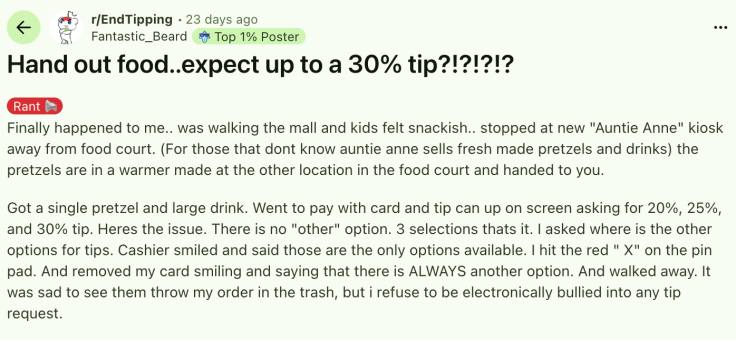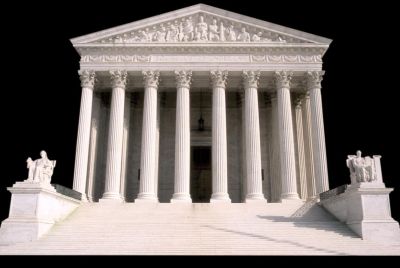Outrage as Auntie Anne's Pretzel Kiosk in US Asks for Minimum 20% Tip — With No Option to Say 'No'
A mall shopper's refusal to tip 20%, 25%, or 30% for counter service has reignited public frustration over "tipflation"

A simple snack run has become the latest flashpoint in America's growing war over tipping culture.
On Reddit's r/EndTipping forum, one user shared their frustration after stopping at a mall kiosk for a drink and a pretzel—only to be met with a digital payment screen that offered three tipping options: 20%, 25%, or 30%. There was no 'other' button. No 'no tip' choice. Just three large rectangles pressuring them to tip up to nearly a third of their total for what was essentially counter service.
'There's no 'other' option,' the user wrote. 'Three selections. That's it.' The post quickly went viral, drawing hundreds of comments and reigniting a long-running debate about how tipping in the US has gotten wildly out of hand.
In the thread, commenters vented about what many called 'tip coercion'—the way digital payment systems use pre-set percentages and guilt-driven design to push people into tipping more than they might otherwise. 'Thirty percent? For handing me a pretzel?' one wrote. 'This has gotten way out of control.' Another added that screens are increasingly offering only higher percentages—20, 25, 30—while removing the once-standard 10% or custom tip fields altogether.
Not everyone agreed. A few users defended the prompts, reminding others that many workers still depend on tips to make ends meet. But most felt that point-of-sale guilt had gone too far, especially for basic transactions that involve no table service, no hospitality, and often, no meaningful interaction at all.
The discussion quickly broadened from one frustrated customer to a much larger question: how did American tipping culture get here?

For decades, the US has maintained a system that pays tipped employees a 'subminimum wage'—as little as $2.13 per hour under federal law—with the expectation that tips will cover the rest. This effectively outsources labor costs from employers to customers. While the system has survived for generations, it has become increasingly controversial in an age of digital payments and rising living costs.
Some regions have tried to fix it. In Washington, D.C., for example, voters passed a law known as Initiative 82 to phase out the tipped wage and ensure service workers earn the same minimum wage as everyone else. The idea was to stabilize income and make tipping optional again. But after its implementation, many small restaurants complained of skyrocketing labor costs, staff cuts, and menu price hikes. Earlier this year, the D.C. Council even voted to pause the next round of wage increases, citing fears of business closures.
It's a familiar cycle: efforts to make wages fairer often backfire in practice. When employers are forced to pay more, they raise prices. Customers, in turn, face higher bills and more aggressive tipping prompts. Workers end up caught in the middle, unsure whether they'll earn more or lose hours.
In the words of one Redditor, 'It's damned if you do, damned if you don't.' The current system leaves everyone frustrated—businesses, workers, and customers alike.
Still, the scene that sparked this debate—a customer balking at a 30% tip for a pretzel—perfectly captures what so many Americans are feeling: that tipping has morphed from a gesture of gratitude into a moral test.
Until systemic changes are made, it seems those little screens will keep flashing higher percentages, and customers will keep asking themselves the same uneasy question: When did generosity stop being optional?
© Copyright IBTimes 2025. All rights reserved.





















